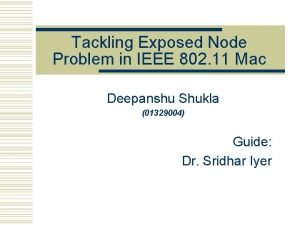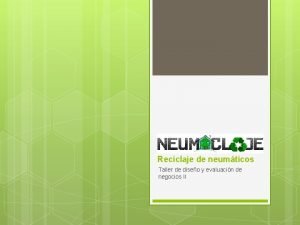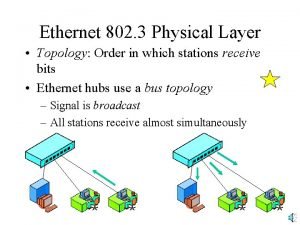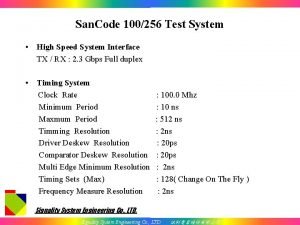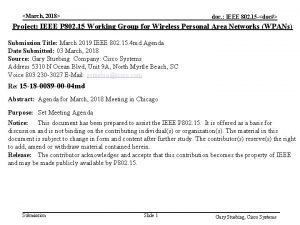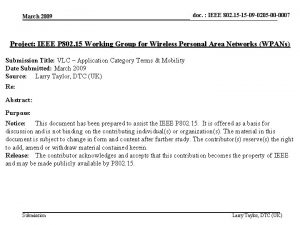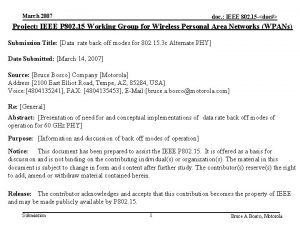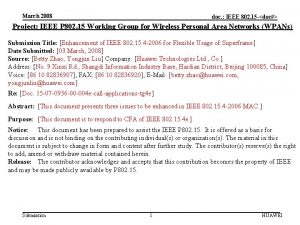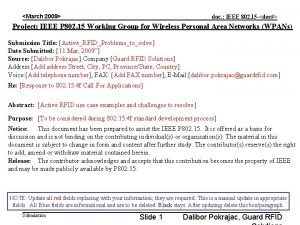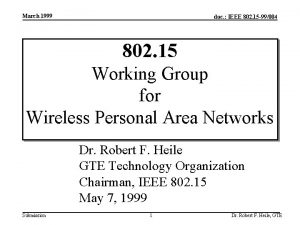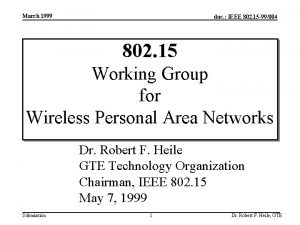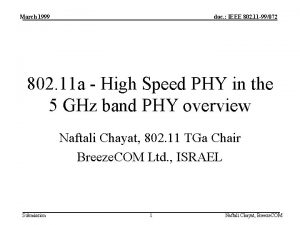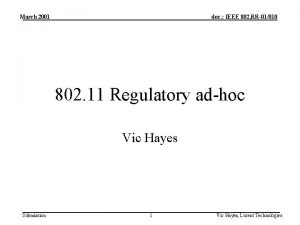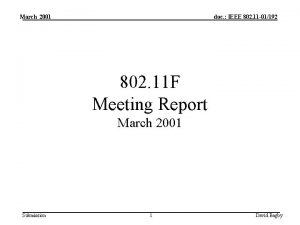doc IEEE 802 11 100256 r 0 March














- Slides: 14

doc. : IEEE 802. 11 -10/0256 r 0 March 2010 Proposal of Synchronized Quiet Period for Incumbent User Detection Date: 2010 -March Authors: Submission Slide 1 Zhou Lan NICT

doc. : IEEE 802. 11 -10/0256 r 0 March 2010 Abstract • This document proposes a Quiet Period synchronization mechanism for 802. 11 af to guarantee the detection of the incumbent user Submission Slide 2 Zhou Lan NICT

doc. : IEEE 802. 11 -10/0256 r 0 March 2010 FCC Rules Regarding Incumbent User Protection • Refer to FCC 08 -260 page 103 • “TV channel availability check time. A TVBD is required to check for TV signals for a minimum time interval of 30 seconds. If a TV signal is detected on a channel indicated as available for use by the database system, the device will provide a notice of that detection to the operator of the device and a means for the operator to optionally remove the channel from the device’s list of available channels” • “In-service monitoring. A TVBD must perform in-service monitoring of an operating channel a minimum of once every 60 seconds. There is no minimum channel availability check time for in-service monitoring” Submission Slide 3 Zhou Lan NICT

doc. : IEEE 802. 11 -10/0256 r 0 March 2010 Dynamic Frequency Selection (DFS) • Associating STAs with an AP in a BSS based on the STA’s supported channels • Quieting the current channel so it can be tested for the presence of radar with less interference from other STAS • Testing channels for radar before using a channel and while operating in a channel • Discontinuing operations after detecting radar in the current channel to avoid further interfering with the radar • Detecting radar in the current and other channels based on regulatory requirement • Discontinuing operations after detecting radar in the current channel to avoid further interfering with the radar • Requesting and reporting measurements in the current and other channels • Selecting and advertising a new channel to assist the migration of a BSS after radar is detected Submission Slide 4 Zhou Lan NICT

doc. : IEEE 802. 11 -10/0256 r 0 March 2010 Necessity of Synchronized Quiet Period • DFS has defined the procedure to quiet the current channel so the channel can be tested for the presence of the incumbent services • However according to the procedure (11. 9. 1 IEEE Std 802. 11 -2007), the affected STAs are confined inside the same BSS or IBSS • During the period when STAs in a certain BSS are quieted, STAs in an adjacent BSS may still be allowed to transmit • As a consequence, in the quiet period which is supposed to be used to detect incumbent users, there might be signals from adjacent BSSs, which interfere the detection of incumbent users • It is important to have a synchronization mechanism to guarantee the clearance of the quiet period for incumbent user detection Submission Slide 5 Zhou Lan NICT

doc. : IEEE 802. 11 -10/0256 r 0 March 2010 Illustration of the Problem B BSS 1 BSS 2 BSS 3 B B Quiet B Quiet B TV broadcaster BSS 3 BSS 1 BSS 2 DS Submission Slide 6 Zhou Lan NICT

doc. : IEEE 802. 11 -10/0256 r 0 March 2010 Assumptions • This is no need to mandate Timing Synchronization Function (TSF) for the STAs involved • There is a means to allow APs exchange information using wireless or wired transmission • The Quieting Channel for Testing function defined in 802. 11 2007 will be used for each BSS to adjust the individual quiet period to align with the requested quiet period Submission Slide 7 Zhou Lan NICT

doc. : IEEE 802. 11 -10/0256 r 0 March 2010 Usage of the Synchronized Quiet Period • The purpose of the Quiet Period Synchronization is to guarantee a clear period that will not be used by any 802. 11 STAs in the concerned area to meet the requirement of incumbent user detection specified by FCC • A Quiet Period Synchronization request is sent by an AP to the APs that are members of the ESS as requested in the Quiet Period Synchronization • The mechanism by which the list of APs in the ESS is determined is outside the scope of this amendment • The mechanism and algorithm by which to decide which AP will send the Quiet Period Synchronization is outside the scope of this amendment • The Quiet Period Synchronization request may be sent through wired or wireless connection • Upon receiving the request, an AP shall respond whether it will perform the Quiet Period Synchronization operation Submission Slide 8 Zhou Lan NICT

doc. : IEEE 802. 11 -10/0256 r 0 March 2010 Requesting a Synchronized Quiet Period • An AP requesting to start a Quiet Period Synchronization procedure shall send a Quiet Period Synchronization Request frame to the APs that are located in the concerned area • The Quiet Period Synchronization Request frame contains a dialog token to distinguish requests from different APs • The Quiet Period Synchronization Request frame contains the BSSID of the APs that the request is sent to • The Quiet Period Synchronization Request frame contains requested timing information for quiet period synchronization – Quiet Period Offset: specify the time offset of the starting time of the quiet period relative to the reception of the preamble of the Quiet Period Synchronization Request frame – Quiet Period: specify the interval between two Quiet Periods – Quiet Duration: specify the duration of the Quiet period Submission Slide 9 Zhou Lan NICT

doc. : IEEE 802. 11 -10/0256 r 0 March 2010 Receiving a Request of Synchronized Quiet Period • An AP upon reception of a Quiet Period Synchronization Request frame checks the BSSID contained in the request and shall respond if the BSSID matches • If the AP is able to adjust the quiet period according to the request, a positive response shall be sent back to the AP initiated the request • If the AP is not able to adjust the quiet period, a negative response with the reason code shall be sent back the AP initiated the request Submission Slide 10 Zhou Lan NICT

doc. : IEEE 802. 11 -10/0256 r 0 March 2010 Synchronized Quiet Period Request Frame • Quiet Period Synchronization Request frame is a Public Action Frame Octets: Category Action Dialog Token Protocol Information Element Quiet Period Synchronization Request Element 1 1 2 3 variable Submission Slide 11 Zhou Lan NICT

doc. : IEEE 802. 11 -10/0256 r 0 March 2010 Synchronized Quiet Period Response Frame • Quiet Period Synchronization Response frame is a Public Action Frame Octets: Category Action Dialog Token Protocol Information Element Quiet Period Synchronization Response Element 1 1 2 3 variable Submission Slide 12 Zhou Lan NICT

doc. : IEEE 802. 11 -10/0256 r 0 March 2010 Synchronized Quiet Period Request Element • Quiet Period Synchronization Request element Octets: Element ID Length 1 1 Submission Request Quiet Period Token Offset 2 2 Slide 13 Quiet Period Quiet Duration Optional Sub-elements 1 2 variable Zhou Lan NICT

doc. : IEEE 802. 11 -10/0256 r 0 March 2010 Synchronized Quiet Period Response Element • Quiet Period Synchronization Response element Octets: Element ID Length Request Token BSSID Result Reason code 1 1 2 6 1 1 Submission Slide 14 Zhou Lan NICT












